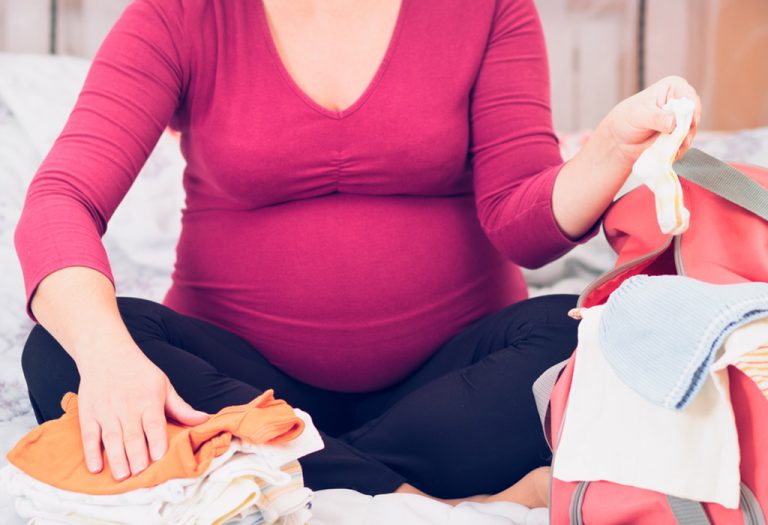How to Check Your Cervix for Dilation

- What Is Cervix Dilation?
- Why Should You Check Your Cervix for Dilation?
- Steps to Check Your Cervix for Dilation
- Preparation to Check Your Cervix for Dilation
- Checking the Dilation of Your Cervix at Home
- Look for These Additional Signs of Cervix Dilation
- When Not to Check Your Cervix During Pregnancy
- Reasons Why Your Cervix Is Not Dilating
- FAQs
Towards the end of pregnancy, parents-to-be are on the constant lookout for signs that may indicate the welcome of their baby. In the last trimester, you might have heard your doctor talking about the cervix dilation, i.e. the opening of the cervix for the baby to pass through. Although the checking cervix dilation is done by the health experts mostly, it can be also checked at home by you. To know if you are ready to give birth or not, you must check your cervix for dilation.
What Is Cervix Dilation?
The cervix plays an important role in a woman’s body during the process of childbirth. When the due date of delivery approaches, pregnant women feel contractions. These contractions are nothing but the tightening of the uterus and dilation of the cervix. The cervix which is usually closed to keep the baby safe during pregnancy becomes dilated, i.e., opens. The dilation of the cervix makes it possible for the baby to move from the uterus to the vaginal canal. The cervix dilates from 1 centimetre to 10 centimetres before a woman goes into active labour. This is the first stage of labour.
Why Should You Check Your Cervix for Dilation?
It is beneficial to know your body when you are going through the life-altering process that is pregnancy. It will help you determine what stage of labour you are in and whether the baby is ready to come out. Checking your cervix for dilation will let you know if you can begin to push the baby out. However, it is always a certain answer to the labour However, if you are not confident or unsure of doing so, it is best to avoid it.
Checking your own cervix for dilation can help you in the following ways:
- It gives you control over your body during labour, which is an emotionally and physically intense situation for a woman.
- Relying on lab tests can be time-consuming and you will have to wait for the results. Checking your own cervix for dilation will let you know the results immediately.
- Checking whether your cervix is dilated well will prepare you for the final stages of labour.
- You know your body better than anyone else, so you can do these tests at home without the risk of infections due to external equipment and so on.
Steps to Check Your Cervix for Dilation
Checking your cervix for dilation is important to be aware of the stages of labour. Before you go into the details of the process, it is important to be prepared to keep your cervix free from infections. Here are the basic preparations you need to do before checking your cervix for dilation:
Preparation to Check Your Cervix for Dilation
Here is how can you can prepare to check your cervix for dilation at home:
1. Clean Your Hands Thoroughly
Your hands should be washed thoroughly and disinfected to ensure that there are no germs that enter your uterus and cause infections when you check it for dilation. Use a good hand sanitiser on your hands. Ensure that your fingers and fingernails are well-maintained to avoid internal cuts and bruises and infections.
2. Take Advice From Medical Professionals
To make sure you and your baby are healthy, it is important that you talk to your doctor. As the ninth month of your pregnancy approaches, your doctor will look for signs of labour. He may do an exam to see if your cervix has dilated or not and whether the baby has turned his head down or not. You should also ask your doctor if you can check your cervix for dilation at home. If he says yes, then you can proceed.
3. Work as a Team With Your Partner
Although your body is going through the rigours of pregnancy, you can involve your partner to help you through this. Having your partner by your side gives you the moral support that you need during labour.

4. Get Comfortable
Get into a comfortable position before you check your cervix for dilation. The most preferred position is to squat with both your legs as much as possible. If possible, you can even sit on the floor with your legs up front and lift one of your legs up on a sofa or an elevated surface.
Now that we have covered the basic preparations for checking your cervix for dilation, let us go through simple steps that you can follow to check the dilation of your cervix in your home.
Checking the Dilation of Your Cervix at Home
You can check the dilation of your cervix at home by performing the following steps:
1. Insert Your Index and Middle Finger in Your Vagina
Ensure that your fingers are clean and sterilised as much as possible using solutions containing over 60% alcohol, like hand sanitisers. After cleaning, find the opening of your vagina with your fingertips and push the two fingers into your vagina.
2. Push the Fingers Deep to Reach the Cervix
The cervix is located at the end of the birth canal and is the opening of the uterus. Hence, push your fingers in deep to reach the cervix. Make sure not to put pressure or poke to avoid bruises and the breaking of the amniotic sac. Be gentle and probe around with your fingers. A dilated cervix will let you feel the amniotic sac. It will feel like a balloon filled with water. In a cervix fully dilated up to 10 centimetres, you can even feel the baby’s head crowning.
3. Probe Further to Understand the Level of Dilation
If you are able to pass a finger through your cervix, it can be considered as a 1-centimetre dilation. Two fingers imply 2 centimetres dilation, and so on.
4. Get Medical Help
A dilation of 3 centimetres or above is a sign of labor. In such a case, it is always advisable to go to a hospital.
Look for These Additional Signs of Cervix Dilation
You can also look for these additional signs that may indicate cervix dilation. However, these are on a case-to-case basis and may not hold true every time.
1. Pay Attention to the Sounds You are Making
At 1-4 centimetres of dilation, it is very easy to make conversation normally. At 4-5 centimetres, it will be nearly impossible for you to talk. At 5-7 centimetres, you will be making very loud noises as the pain increases. At 7-10 centimetres, you will be making louder noises as you reach the ultimate level of your pain and cervical dilation.
2. Scan Your Emotions
At 1-4 centimetres of dilation, you will be elated and laughing at different things. At 4-6 centimetres of dilation, you will be smiling and laughing at small things. At later stages between 6-10 centimetres, you will get irritated even at very small things.
3. Check for Smells of Dilation
Pre-natal scents have a characteristic deep smell. If you notice a stark change to the scent of the room in which the delivery is happening, it is a sign that your cervix has dilated to around 6 to 8 centimetres.
4. See If There Is Blood and Mucus
If you see blood and mucus which is of a characteristic brown or pink colour from your vagina, it is a sign that you are about 6 to 8 centimetres dilated.
5. Feeling Nauseated
The feeling that you get that you have to vomit is a characteristic of a 5-centimetre dilation.
6. Curling of Toes
Curling your toes or trying to stand on your toes is a sign of a 6 to 8-centimetre dilation.
When Not to Check Your Cervix During Pregnancy
Checking the cervix for dilation should be avoided at all costs in the following scenarios:
- If a trained medical professional has advised you against it, you should stay away from checking your cervix.
- If you have had pre-labour or dilation issues in the past, you should avoid checking your cervix.
- If you have a cervical stitch to avoid miscarriages and pre-term births, you should not do external checks on your cervix.
- If you have placenta previa, avoid checking your cervix.
- Do not check your cervix if your water has already broken as you will risk introducing bacteria to your birth canal.
Reasons Why Your Cervix Is Not Dilating
If you are near your due date, yet your cervix hasn’t started dilating, it means your body is not ready for labor. It may be the reason that your contractions are not strong enough for the cervix to open. In cases where the cervix is not dilated naturally, many doctors may suggest inducing labor via medical or physical methods. If none of the options works to dilate the cervix well, doctors may suggest a c-section.
Cervix dilation is an important part of childbirth. So, whether you are dilated just 1 cm or not at all with your due date approaching, do not stress yourself; you will eventually get there. Relax, calm yourself down and focus on good things.
FAQs
Is getting your cervix checked painful?
A vaginal exam is understandably an uncomfortable experience for many women. However, it mostly does not hurt when the healthcare experts check for dilation. It may cause discomfort in many people since checking the vaginal area manually can somewhat feel invasive. It mostly happens with first-time to-be-moms as every process during pregnancy is new to them. But, in case you feel any pain during the checking for dilation, do inform your doctor about it so that they can take necessary changes for your comfort.
Can checking for cervix dilation cause labor?
No, checking for cervix dilation does not induce labour unless it is done voluntarily. In case you are due for your labor and your cervix hasn’t dilated much, your doctor may recommend a cervical exam which may be in conjuncture with inducing labor. But be sure to ask your doctors whether it is required or not.
Pregnancy, labour, and finally having a baby in your arms are life-changing experiences that bring you and your partner immense happiness. These tips to check your cervix for dilation can help you be better prepared for labour and delivery.
Also Read:
Tips for Easy Labour and Delivery
Interventions during Labor and Delivery

















